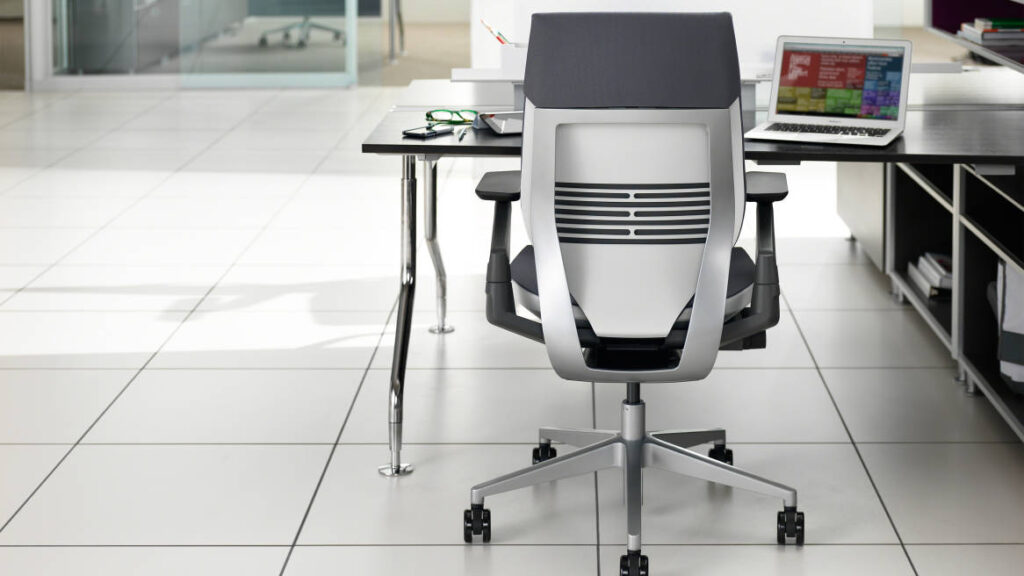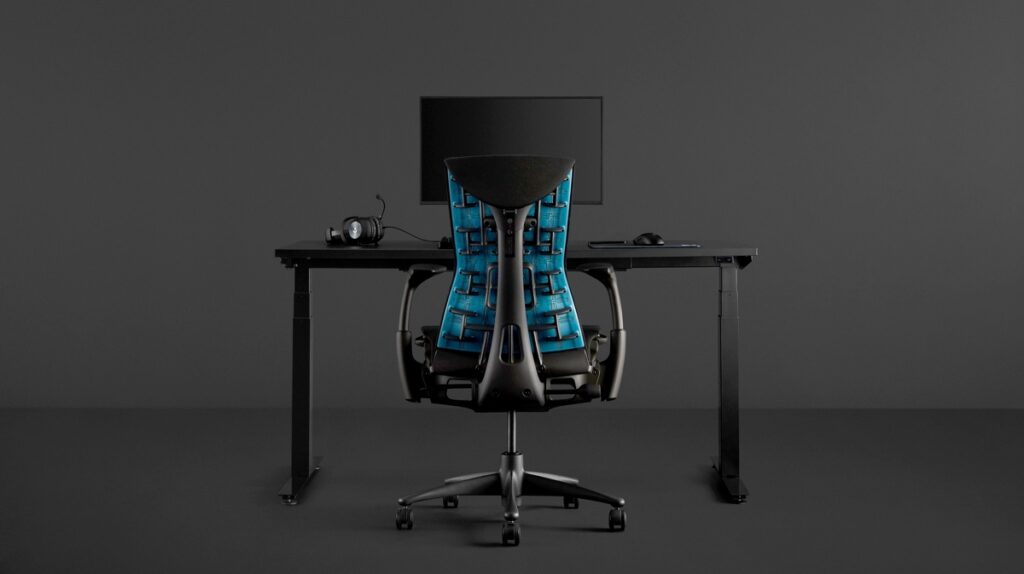If office chairs were boxers, then the battle between the Steelcase Gesture and the Herman Miller Embody would be the heavyweight fight of the decade. These are essentially both company’s top-end ergonomic office chairs, featuring all of the bells and whistles that we expect nowadays. These are truly top of the line office chairs in every sense. But which is better, the Steelcase Gesture VS Herman Miller Embody. Well, we’ll see if we can wade through the specs and let you know which is ultimately a better chair for most users.
The Herman Miller Embody offers more value for money than the Steelcase Gesture given its unique back support system and more durable parts. The Embody may not have a headrest option, but it excels in ergonomic comfort as well as general “premium feel” over its competitor. If we had to choose one office chair to buy (and budget was no object) it would be the Herman Miller Embody. If you are a larger individual, the Gesture’s arm width adjustment and superior seat depth adjustment may be a reason to go for Steelcase.
While both the Gesture and the Embody are both great chairs, we would have to give the nod to the Embody since it sells for several hundred dollars less than the Steelcase Gesture. These chairs are so similar that we don’t think you’re really getting anything extra for the cost of the Gesture. In fact, the unique lumbar support of the Embody is just a bit better in our opinion and the general quality of components is better on the Embody.

Best office chair: Herman Miller Embody
The leader of the pack when it comes to both quality, USA-made components and adjustability. The Herman Miller Embody chair takes everything Herman Miller learned from the iconic Aeron and dials it up to 11, resulting in the best overall office chair we have used.

Also great: Steelcase Gesture
Arguably this is a more adjustable chair when it comes to larger bodies, making it a great pick for those individuals. The Mexican-made parts don’t feel like quite the same high quality as the Embody, but some people find the Gesture to be even more comfortable for long periods of time.
Specifications: Steelcase Gesture VS Herman Miller Embody
| Steelcase Gesture | Herman Miller Embody | |
|---|---|---|
| Height | 39¼” – 44¼” | 42-45” |
| Seat height | 16″ – 21″ | 16–20.5” |
| Width | 22 3/8″ – 34 5/8″ | 29.5” |
| Depth | 21″ – 23 5/8″ | 26.5” |
| Seat depth | 18¼” | 15-18” |
| Weight | 73 lb | 51 lb |
| Maximum weight | 400 lb | 300 lb |
| Seat material | 3D knit fabric | Fabric/upholstery |
| Frame material | Aluminum | Aluminum |
| Head rest available | Yes | Yes (part of back) |
| Size(s) | One size | One size |
| Lumbar support | Yes (add-on) | Yes, Backfit |
| Lumbar tension control | No | No |
| Adjustable seat depth | Yes | Yes |
| Back height adjustment | No | Yes |
| 4 way adjustable arms | Yes | Yes |
| Arm rest height adjustment | Yes | Yes |
| Arm pivot adjustment | Yes | Yes |
| Arm width adjustment | Yes | Yes |
| Recline | Yes | Yes |
| Recline back stop | Yes | Yes |
| Recline tension adjustment | Yes | Yes |
| Forward seat tilt | No | No |
| Casters available | Normal, carpet | Normal, carpet |
| Assembly required | No | No |
| Warranty | 12 years | 12 years |
| Environmental rating(s) | Level 3 ANSI/BIFMA | Level 3 ANSI/BIFMA |
Size(s)
Both the Steelcase Gesture and the Herman Miller Embody are designed to be one-size-fits-all. This is because they both feature some of the most customizable adjustments in the office chair business. Literally, every ergonomic adjustment that exists is possible on both of these chairs. This means that these chairs will work great for 95% of users. Larger people may want to consider the Gesture due to its width adjustable armrests, however.
One thing that is absent on the Herman Miller Aeron, but was added to the Embody is seat depth adjustment. This means that individuals with longer femurs will be able to adjust the seat to fit their needs. The Embody is also slightly taller than the Gesture, so taller people may want to consider it.

Weight & weight capacity
The Steelcase Gesture is actually rated at a full 100 lb heavier weight capacity at 400 lb. So, yet again, the Gesture may be a better fit for heavier and wider individuals. In terms of the weight of the chair itself, the Embody is substantially lighter at 51 lb versus the Gesture’s 73 lb.
Materials
The Steelcase Gesture uses the excellent 3D knit upholstery that was made popular with the Leap V2. The Gesture comes in two varieties when it comes to the fabric. You can leave the back completely open, to show off the unique spine design, or you can have the fabric wrap all the way around. The Embody is immediately recognizable due to its “pixel” back design. This open-back design is complemented on the front with very high-quality fabric.
The frame materials on both chairs are made of high-quality aluminum. However, the Steelcase Gesture has more plastic accents and pieces than the Embody. This isn’t really an issue, since we know how high tolerance these plastics are on Steelcase chairs, but it is something to note. The somewhere subjective “solidness” feeling on the Embody just seems a bit higher in general.
Colors
The Steelcase Gesture comes is several color combinations and finishes:
- Black
- Dark (a dark grey color)
- Light (a light grey color)
- Dark / Light (light grey legs and dark grey upper frame)
- Polished aluminum (legs only)
The Herman Miller Embody, on the other hand, comes in the following finishes:
- White / Titanium
- Graphite / Titanium
- Graphite / Graphite (all black)
- White / Graphite
Both chairs have a crazy number of options for fabric customizability, especially on the Office Designs website (which weirdly has way more options than even the Herman Miller website). The Gesture comes in 38 different colored fabrics and the Embody tops that at 42 different colors. So you can really customize the heck out of either of these chairs.

Seat comfort
This one is almost always split. Some prefer the thickness and plushness of the Embody’s large seat as well as the way their fabrics can adjust to tiny differences in pressure (even things as subtle as pant pockets). Others swear by the way that the seat pan on the Gesture flexes with the body.
The seat depth adjustment on the Embody is incredibly natural with the way it slides out, without you having to get up to adjust it. The Gesture’s seat depth adjustment is arguably even better and is a standout feature for this chair. The one thing that just feels “right” with the Gesture is the way the seat rolls off at a nice angle where it contacts the back of your knee, making it super comfortable and guarding against any pressure points on the legs and thighs.
Adjustability
Lumbar/spine support
This is really why you are looking at these two chairs right? You want to be able to basically mold these chairs to your specific body type through ergonomic adjustments.
Both chairs feature some pretty space-age back adjustment technology. The Steelcase Gesture features their 3D Live Back technology which provides varying levels of support as you recline on the chair. We probably still prefer the lumbar tension system that is on the Steelcase Leap, but the lumbar support on the Gesture is still great. The Embody uses Herman Miller’s “pixel” system for providing spinal support across all parts of the chair back independently. I personally find that I like the way the Embody cradles my back a little more than the Gesture and the micro-adjustments in the pixelated support seem to really do their job well. I also love the backstop “trigger” that is on the Embody. It features several levels that will lock the back from reclining too much. This is a common feature on ergonomic chairs, but I find the adjustment super easy to do on the Embody.
Back height adjustment
Only the Herman Miller Embody includes seat back height adjustments. While both chairs are built to have high backs, you may want to consider the Embody if you are particularly tall.
Seat depth adjustment
As mentioned above, both the Gesture and the Embody have seat depth adjustments. The one on the Gesture is done using a roller-design which can be easily done while you are still seated. The Embody’s seat depth is adjusted with a little knob that pulls forward. They both work just fine, but I would say the Gesture’s feels a little more natural and you can really dial in some tiny adjustments.
Arm adjustments
This is the one category where the Steelcase Gesture is a stand-out winner. Their 4-way adjustments on their arms are amazing. The way you can swing the arms out from the body of the chair allows for wider individuals to comfortably sit in the Gesture. The Embody’s arm adjustments are just about as good, but just do not have this width adjustment. The way their width adjustment works is the arms will pivot outwards instead (which is not as good in my opinion).
Wheels
There’s nothing too special about the wheels on both the Gesture and the Embody. You can get hard surface and carpet casters on both. The Embody’s casters do have “roll-away” resistance which will apply some pressure to the wheels to essentially brake the chair if it starts rolling.
Headrest
The Steelcase Gesture can be bought with an add-on headrest, while the Embody just does not have this option at all. The height back adjustment on the Embody makes up for this a bit, but if you are someone who prefers a full headrest for long gaming or writing sessions, you may want to go with the Gesture over the Embody.
Durability
This is another section that is a little subjective. Both the Gesture and the Embody are built to super-high tolerances, with excellent parts. In the actual everyday use of the chairs, however, the Embody just “feels” better in terms of durability. More metal and very hard polycarbonate surfaces on the Embody and a feeling of solidness permeate the experience. The Steelcase Gesture is a heavy chair, and it is certainly no slouch. But the use of plastic on more critical parts makes it feel a little less premium, especially for the price.
Both chairs use fabric on the seatback which could experience staining over time. The Gesture is available in upgraded leather which can guard against this wear and tear.
Resale value
These are both newer office chairs, but already we are seeing a very healthy after-market resale value for both. Like other premium ergonomic office chairs, the Gesture and Embody will retain a lot of their value over time.
Price
The Steelcase Gesture is a little more expensive at its base configuration than the Embody. But they are pretty much on par in terms of price. If you opt for polished aluminum on the Gesture’s frame or the wrap-around fabric option, it will boost the price by a couple of hundred dollars over the Embody. At the end of the day, these are the flagship chairs for both companies, so you will be paying a premium over, say, the Aeron or the Leap V2 which are great chairs in their own right.
Warranty
Both the Gesture and the Embody have a 12-year warranty from Steelcase and Herman Miller. In our experience (1) these chairs very rarely have an issue, and (2) if they do, both companies have top-notch after-purchase service.
Unique features on the Steelcase Gesture
The Steelcase Gesture is probably the most adjustable office chair available. Even above the Embody. The arm width adjustments and seat depth adjustments take everything to the next level. If you have a larger frame, you may want to consider the Gesture over the Embody to take advantage of these features.
Criticisms of the Steelcase Gesture
It can be argued that the Gesture doesn’t quite add enough extra to the recipe to warrant such a large increase in price over its little brother, the Leap V2. Yes, this is a better chair all around, but is it worth almost double the price?
Unique features on the Herman Miller Embody
The Herman Miller Embody really showcases its uniqueness outwardly with its unique pixelated back support design. There really isn’t anything like this out there right now. The micro-adjustments that the back can make because of this design are absolutely amazing and are worth the price of admission over cheaper Herman Miller models like the Aeron and direct competitors like the Gesture.
Criticisms of the Herman Miller Embody
For some people, the pixelated back structure on the Embody can actually be “felt.” And the back of the Embody tends to have a forward tilt to it which doesn’t always feel great for all users. But overall I’d say 90% of users find the Embody to be super comfortable.
Conclusion: The best premium home office chair
The Steelcase Gesture and the Herman Miller Embody are meant to compete head to head. And in the Steelcase Gesture VS Herman Miller Embody battle, there is only one winner: the Embody. The unique back support system, superior build quality, and more fabric customization options make this truly the best office chair we have used.



I’m really surprised to hear that you enjoyed the Embody more than the Gesture, especially due to the back rest. That was my major complaint. I guess chairs are super subjective. I wrote up a similar style review to yours here that might be helpful to someone considering these two chairs as I felt completely the opposite.
https://node14.com/Public/Blog/EmbodyVsGesture.aspx